Last Updated on January 6, 2024 by Greg Gillson
Do you love to feed birds in winter? It can be a source of joy on those dreary winter days.
However, there is much confusion about when to stop feeding birds when winter is over. When should you stop feeding birds in summer? Here is the good news!
You don’t have to stop feeding birds in summer. You can feed birds all year round.
The one exception is if you live in bear country. If you have bears, stop feeding birds when bears come out of hibernation.
But, of course, you may stop feeding birds whenever you get tired of it! You may stop feeding birds when spring migration is over. You may stop feeding birds when all you have left at your feeders are the summer House Finches and House Sparrows.
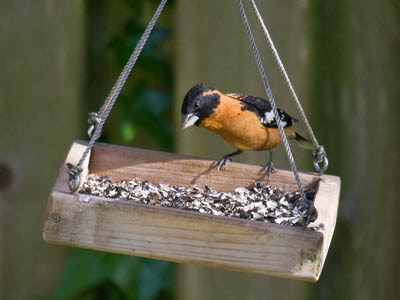 |
| Black-headed Grosbeak at a summer feeder Photo by Greg Gillson |
You don’t have to stop feeding birds in summer!
For most people who feed birds there is no reason to stop feeding birds at the end of winter. The spring migration and summer nesting season brings new seed-eating birds to your backyard feeder. And if you vary the type of food you offer birds, the variety of birds you may attract increases dramatically.
Across the United States in summer there are the bright red House Finches with their lively songs. American Goldfinches come to your feeders in their brightest yellow and black summer plumage. Colorful Rose-breasted Grosbeaks in the East and Black-headed Grosbeaks in the West are common backyard birds that will visit your feeders. Northern Cardinals visit feeders all year-round in the East.
And don’t forget that across the U.S. there are Downy Woodpeckers that visit feeders year-round. So do Black-capped Chickadees and Red-breasted Nuthatches in the northern states, Carolina Chickadees and Red-bellied Woodpeckers in the East. And Mourning Doves visit feeders throughout the year in all parts of the Nation. Oh, and I nearly forgot about the Eastern Towhees and the Spotted Towhees.
There are jays and House Sparrows, too. Though most people don’t really care to feed these latter birds.
Don’t worry that your feeders will keep the wintering birds from migrating back north in the spring. It just doesn’t happen. The migratory urges are stronger than even food.
And don’t worry that if you stop feeding birds they’ll starve. Summer or winter, bird feeders only provide supplemental food. They can survive without our feeding them except, perhaps, during extended snow or ice storms.
 |
| A good reason to stop feeding birds in summer! Image by Marie Gayas from Pixabay |
Stop feeding birds in summer if you live in bear country!
There is one good reason to stop feeding birds as soon as early spring, though–bears!
When I think of bear country, places like Maine and Minnesota and Yellowstone come to mind.
But there are bears in Upstate New York. There are bears in Florida. There are bears throughout California–even within 100 miles of Los Angeles!
Even if you live in these areas, chances are you may never have seen a bear outside a zoo. But those people who live on the edge of the wilderness, or in mountain communities, have to be aware of bears. Basically, if you live in bear country, you cannot leave out any trash or food–including bird seed. Otherwise they’ll keep coming back and becoming a nuisance.
In some places, because of bears, it is only safe to feed birds from mid-December to mid-March (“Christmas to St. Patrick’s Day”). Check your local ordinances. Many communities in bear country have regulations concerning when bird feeding is allowed.
But for most of us, the thought of bears at the feeder doesn’t even come to mind.
Other times to stop feeding birds in summer
Depending upon where you live, you may wish to stop feeding birds in the summer, even if you don’t have to. Here are some reasons that come to mind. Perhaps you can think of more.
Stop feeding birds when spring migration is over
You can stop feeding birds as soon as the cold and snowy winter weather is over. Many people stop at this time.
But I suggest waiting until May or even June to take down your feeders. Your winter birds may wait until late April to leave. And there is another reason to keep your feeders up until summer.
The reason to wait is that many seed eating birds will be passing through your yard during migration. And they’ll be hungry!
Much of the sparrow migration happens in March and April. Widespread White-crowned Sparrows migrate north across the country, White-throated Sparrows in the East, Golden-crowned Sparrows in the West. Other sparrows, too. Savannah Sparrows. Chipping Sparrows. Lark Sparrows. These all visit feeders in spring.
The buntings and grosbeaks migrate through in April and May. These are beautiful birds. Indigo Buntings in the East. Lazuli Buntings in the West. And we’ve already talked about the Rose-breasted Grosbeaks in the East and Black-headed Grosbeaks in the West.
These birds may pass through your backyard on the way north. Or you may live where these birds breed. Thus, they’ll be around all spring, and bring their young birds to your feeder in later summer.
 |
| House Sparrow Photo by Greg Gillson |
Stop feeding birds when all you have left are House Finches and House Sparrows
In southern areas, or perhaps more urban settings, there may not be many birds at your feeders in summer.
In more northern areas, though, there are many seed eating birds that visit feeders all year.
The resident House Finches and House Sparrows may be all you have in summer. If so, I don’t blame you for stopping feeding the birds. These flocking birds can be kind of noisy and messy, and eat a lot.
Even the local Mourning Doves may stop visiting the feeder during the nesting season.
By September or October you may see additional birds migrating back south.
Don’t wait too long to set up your winter bird feeders, though! These fall birds move around looking for the best place to spend the winter. By mid-December they are in place. If you wait until then to set up your feeder you won’t attract as many birds. Set up your feeders in November to attract more winter birds.
Stop feeding birds when you get tired of it
Yes, you may just get tired of feeding the birds in summer. It’s oaky; you can stop. You’re not obligated. It doesn’t make you a bad person!
But rather than just stop, try this. Use this break to clean the feeders. Wash them with soap and water or a bleach solution. Take them down and put them away. Clean up the ground under the feeders.
You may find that your feeders need to be replaced. Take note of what feeders you liked, what ones had problems. Then you can purchase feeders that attracted the most birds and worked for you.
You may also use this break to think about planting and landscaping your yard with bird-friendly plants and flowers.
You may stop feeding the birds in summer. But that doesn’t mean you have to take down the bird bath. Water can still attract birds to your yard all summer!
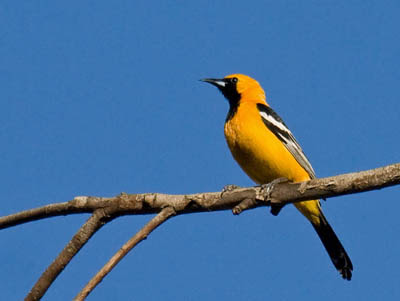 |
| Hooded Oriole Photo by Greg Gillson |
Don’t stop feeding birds, but try different foods for summer
Perhaps you’ll want to stop or reduce the amount of seeds you feed in summer. Experiment with other foods, such as fruit or mealworms.
In the heat you may want to move your summer feeders into the shade. It may keep the foods (especially fruits and nectar) from spoiling as quickly.
And you will want to stop offering suet in summer, when the temperature is consistently over 80° F. It will melt and go rancid quickly.
You may wish to switch to only a thistle sock or feeder in summer with Niger seed. The goldfinches are late summer breeders, even feeding small seeds to their nestlings. So they may appreciate having a reliable source of small seed nearby.
Also, summer is when you should be feeding hummingbirds (really, your feeders should be out in early March to attract the first migrants). Four parts water and one part sugar is the ideal 20% sucrose level that is found in the flowers hummingbirds like.
No matter where you live in the United States there should be at least one species of hummingbird you can attract to your feeders–and more if you live in the West or Southwest.
The nectar solution for hummingbirds is exactly the same recipe as for orioles. You can put up special oriole nectar feeders in summer. Sometimes woodpeckers feed from these! Orioles also eat orange slices and grape jelly. Have you tried it?
When and whether you stop feeding birds in summer is up to you!
Wrapping Up
Attracting feathered friends to your backyard with bird feeders can be a delightful and rewarding experience. Here are some tips to make your bird feeder a welcoming haven for avian visitors:
Location:
- Visibility: Place feeders where you can watch the birds from your window or patio.
- Safety: Mount feeders at least 5 feet off the ground and 10 feet away from trees and shrubs to discourage predators.
- Sunshine and shade: Offer a mix of sunny and shaded spots for different birds’ preferences.
- Multiple feeders: Use several feeders spaced apart to reduce competition and prevent disease transmission.
Feeder Selection:
- Variety: Provide feeders for different types of seeds, suet, fruit, and nectar to attract a wider range of birds.
- Drainage: Choose feeders with drainage holes to prevent water buildup and prevent mold growth.
- Easy cleaning: Opt for feeders that are easy to disassemble and clean, preferably once every two weeks or more often during humid seasons.
Food:
- Freshness: Offer fresh seed, suet, and fruit regularly to avoid attracting unwanted pests and ensure nutritional value for the birds.
- Appropriate food: Research the type of birdseeds, suet blends, and nectar preferred by the birds you wish to attract in your region. Avoid using cracked or moldy seeds.
- Supplements: Offer water sources, especially during droughts, and consider providing grit for digestion for some species.
Frequently Asked Questions
What is the best time of day to feed birds?
There’s no single “best” time of day to feed birds, as their feeding patterns vary depending on species, season, and environmental factors. However, here are some insights to help you choose the optimal times for your backyard bird feeders:
Early Morning:
- Pros: This aligns with birds’ natural instinct to replenish energy after overnight fasting. You’ll likely see a burst of activity at feeders as birds search for food to fuel their morning activities.
- Cons: This peak period can be competitive, leading to dominance by larger birds and leaving smaller ones with less access.
Late Afternoon:
- Pros: Provides another energy boost before nightfall, encouraging birds to stock up for the night. It can also be quieter, giving smaller birds a chance to access the feeders.
- Cons: Depending on your location, late afternoon sunlight might not reach shaded feeders, making them less attractive.
Other Considerations:
- Weather: Extreme temperatures, like scorching afternoons or freezing mornings, might discourage birds from visiting feeders. Adjust your feeding schedule to cooler times of day during such conditions.
- Predators: If your area has many squirrels or other bird predators, consider feeding times when they’re less active. For example, early morning hours might be safer for smaller birds.
- Experimentation: Observe your local bird patterns and experiment with different feeding times to see what attracts the most diverse and desired range of feathered visitors.
Do birds tell each other where food is?
Birds don’t have human-like language to tell each other the exact location of a tasty patch of berries or a buzzing feeder full of seeds. However, they do have several ways to communicate about food sources:
Calls and songs: Birds use a variety of calls and songs to communicate with each other. Some calls might specifically indicate the presence of food, like a chickadee’s “dee-dee-dee” call that alerts other chickadees to a potential food source. Others, like the robin’s cheerful song, might indirectly signal an abundance of food in the area, attracting other robins to join the feast.
Body language: Birds can also use their body language to signal food. For example, a bird excitedly flapping its wings or hopping around a particular spot might be trying to attract other birds to a hidden stash of seeds or a juicy worm.
Following each other: If one bird finds a good source of food, other birds might simply follow it. This way, they can quickly learn about new feeding grounds without having to waste time searching on their own.
Social learning: Young birds often learn about food sources by observing their elders. They might watch their parents forage for food and then follow them to the same spots. This social learning helps young birds avoid wasting time and energy searching for food in unproductive areas.
Scent: While not as important as in some other animals, birds can also use their sense of smell to detect food sources. For example, vultures can smell carrion from miles away, and some seabirds can sniff out fish hidden underwater.
Overall, while birds may not have a map app to share food locations, they have a variety of clever ways to communicate about and discover new sources of sustenance. These avian communication methods help them survive and thrive in a world where food can be scarce and competition is fierce.
________________________________________________________________________________________________
Related Articles:
5 Simple ways to attract more birds to your feeder
When to put up and take down your hummingbird feeders
10 fruits you should be feeding backyard birds
Birds that come to feeders in summer
Birds that come to feeders in winter






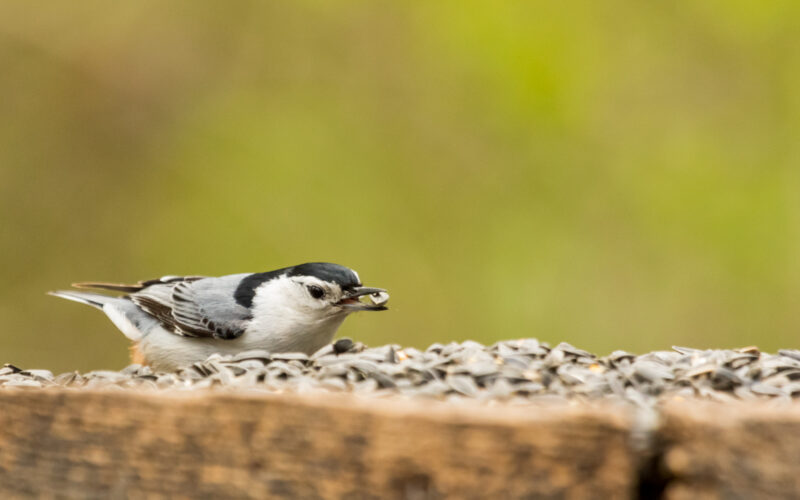
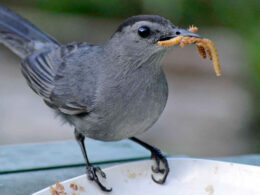
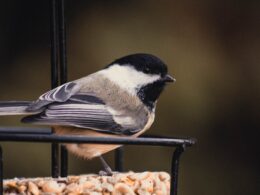
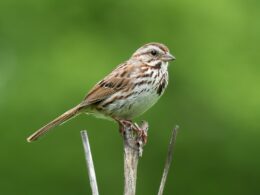
That was a wonderful article. It answered so many questions all at once. I am still feeding the humming birds, doves, gold finch and sparrows and it's Christmas eve in San Diego. They line up on my fence in the morning waiting for the Cafe to open.
How wonderful, Yvonne!
I'm so glad I could help.
Great article! My problem with feeding birds in the summer is all the pigeons it is attracting. What are your suggestions for that? Thanks!
Switch to a tube feeder without a tray or seed catcher under. Just a plastic tube with small perches.
The pigeons are too large to perch on these.
Try looking on Amazon starting with this page for ideas:
https://amzn.to/3uUbszN
I'm very sad today..I had to discard my 2 handmade platform feeders because my neighbor's saw and took photos of a family of 3 rats (they live in a corner of another neighbor's yard under some old conservative blocks) who also love to join the feast along w the birds .squirrels and rabbits. I cannot risk having county authorities calling on me. I guess I can put in pole birdfeeders but I really enjoyed feeding the squirrels, rats and rabbits. Can I throw some peanuts into the holes I see under my fence for the rats..but what do I do for the squirrels. If I ground feed won't everyone including the rats and birds just re visit anyway? I keep the food away from my house on the far side of my backyard adjacent to my other neighbor's fence. To move the food closer I will risk the animals trying to enter my house which so far has not happened.. should I sneakily just try to put small amounts of peanuts near the rats' home until I get the pole feeders for the birds??
I've seen a tremendous increase in rodent population when I put out a seed feeder which is followed closely by a snake population explosion in our area (Upstate New York). I enjoy feeding from a suet feeder during winter which the chipmunks and squirrels don't seem to notice. Are there suet feeder type alternatives for this problem? I'm not interested in experiencing that rodent/snake cycle again.
I've never heard of a rodent/ snake cycle that you describe based on one bird feeder.
Sounds awful! And unfortunately don't have much of a suggestion for you other than to seriously limit food– only enough for the day and sweep up fallen seeds.
Probably best to stop feeding until rat problem is under control.
Thank you so much! We were worrying about what would happen if we stopped feeding in the summer, you have put our minds at rest. 😊
You are welcome!
I’m still feeding an I’m having some cowbirds an a white an black warbler stopping in!
Great article! I have house finches so hoping to see some babies at my feeder here in Iowa!
Yes. You don't have to stop feeding birds in summer!
You'll probably have a bunch of them soon!